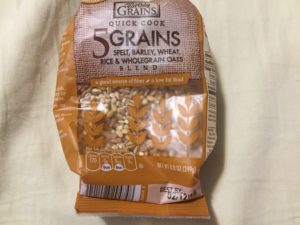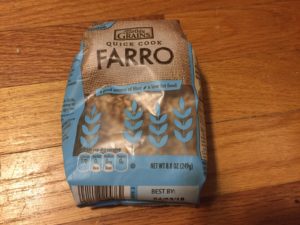This is part two of grains that contain gluten. You can view part one here, if you missed it. Later this week we will be discussing grains that do not contain gluten such as millet, amaranth, quinoa.
 Spelt can be used in place of wheat in any recipe and it is higher in protein than wheat. Spelt is also high in fiber, manganese, and phosphorus and can help play a role in managing type 2 diabetes. If you are using whole spelt berries, they must be soaked at least eight hours before using them for cooking. Spelt flour is lower in FODMAPs than regular flour. In fact, some sourdough bread made with spelt has been labeled “green” or a “safe” food for individuals following a FODMAP diet by Monash University. Read labels though, as many times bread made in the United States has added sweeteners or could be a mix a spelt and durum/bread which would change it’s “safety” when following a low-FODMAP diet.
Spelt can be used in place of wheat in any recipe and it is higher in protein than wheat. Spelt is also high in fiber, manganese, and phosphorus and can help play a role in managing type 2 diabetes. If you are using whole spelt berries, they must be soaked at least eight hours before using them for cooking. Spelt flour is lower in FODMAPs than regular flour. In fact, some sourdough bread made with spelt has been labeled “green” or a “safe” food for individuals following a FODMAP diet by Monash University. Read labels though, as many times bread made in the United States has added sweeteners or could be a mix a spelt and durum/bread which would change it’s “safety” when following a low-FODMAP diet.
Wheat berries are the whole kernel of wheat which includes the bran, germ, and endosperm. Wheat berries appearance is similar to brown rice, but they are sweet, nutty, and chewy. All wheat products, such as wheat flour, are made from wheat berries. Wheat berries are often added to salads or bread to give it a crunchy texture. Cooked durum wheat berries are a popular side dish in France.
 Farro is an ancient strain of wheat and has been a staple among ancient Greeks and Romans. It is best known in Italy. Just like barley, farro can be bought both pearled and semi-pearled. Farro is Italian for ancient wheat grain. Farro is used to describe three different grains: einkorn, emmer, and spelt. In the US and Europe farro is usually referring to emmer wheat. It is usually sold dry and is prepared by cooking in boiling water until soft and chewy. Farro is light brown and has an obvious layer of bran. Farro can be used in salads and risottos.
Farro is an ancient strain of wheat and has been a staple among ancient Greeks and Romans. It is best known in Italy. Just like barley, farro can be bought both pearled and semi-pearled. Farro is Italian for ancient wheat grain. Farro is used to describe three different grains: einkorn, emmer, and spelt. In the US and Europe farro is usually referring to emmer wheat. It is usually sold dry and is prepared by cooking in boiling water until soft and chewy. Farro is light brown and has an obvious layer of bran. Farro can be used in salads and risottos.
KAMUT® used to be eaten in ancient Egypt. KAMUT® is the trademarked name for Khorasan wheat or Oriental wheat. Khorasan wheat is about two and a half times larger than conventional wheat and has a nutty flavor, but it can be difficult to cook due to its size. Khorasan wheat is easy to digest, but still has all the health benefits of whole wheat. According to KAMUT’s® website, “KAMUT® wheat is higher in protein than ordinary wheat and has more essential lipids and amino acids” than whole wheat.
The bags pictured above of Farro and 5 grains (including spelt) can be found at Aldi for $1.69.
